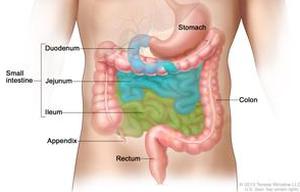

MedFriendly®


Ileum
The ileum is the last, longest, and narrowest of the
three parts that make up the small intestine. The
intestine is a tube shaped structure that is part of the
digestive tract. The small intestine is a part of the
intestine that takes in all of the nutrients (healthy
substances) that the body needs. The ileum is attached
on the top end to the second part of the small intestine,
which is known as the jejunum.
FEATURED BOOK: Creating a Health Balance in the Ileocecal Valve
The point at which the ileum and jejunum connect is not easy to see. The ileum is
attached on the bottom end to the cecum (the first part of the large intestine) through the
ileocecal valve. The large intestine absorbs moisture from the matter that is left after it is
digested in the small intestine, and excretes the waste from the anus. Excrete means to
release from the body as waste. Ileal means pertaining to the ileum.
WHAT DOES THE ILEUM DO?
The main function of the ileum is to absorb nutrients from food that has been digested by
the stomach and the first two parts of the small intestine.
WHAT ARE SOME OTHER CHARACTERISTICS OF THE ILEUM?
The ileum is about 12 feet long in humans. There are millions of villi (more than one villus)
that line the small intestine. A villus is a tiny, thin, fingerlike structure with a blood supply
that sticks out from the surface.
"Where Medical Information is Easy to Understand"™
The villi help to increase the total area on the outside of the small
intestine to the size of about half a tennis court. In this way, the villi
help absorb, move, and distribute some of the fluids and nutrients
into the blood and lymphatic system.The lymphatic system is a
system of vessels that drain lymph from all over the body back into
the blood. Lymph is a milky fluid that contains proteins, fats, and
white blood cells (cells that help the body fight off diseases). The
ileum contains many groups of lymphatic tissue. Lymphatic tissue is
a network of fibers and cells that contain various degrees of
lymphocytes (types of white blood cells). White blood cells help
protect the body against diseases and fight infections.
HOW DOES THE ILEUM DIFFER FROM THE JEJUNUM?
To begin with, the ileum is the last part of the small intestine, whereas the jejunum is the second part. The
ileum is different from the jejunum in that the ileum not as wide and has thinner walls. Although both the
ileum and the jejunum have a few small circular folds (known as pilae circulares), those of the ileum are
smaller and less complex. A fan shaped fold of tissue that holds up the small intestine (known as the
mesentery) has more fat in the ileum than in the jejunum. Also, there are more layers of arteries in the
ileum compared to the jejunum. The vasa recta, which are a group of tiny arteries that run through a part
of the kidneys, are shorter in the ileum than in the jejunum.
WHAT ARE SOME PROBLEMS THAT CAN HAPPEN WITH THE ILEUM?
The ileum can become obstructed (blocked). One example of how this can happen is if scar tissue builds
up after surgery in the belly. A condition called Meckel's diverticulum is when a small, wide sac sticks out
from the ileum and may result in tissue destruction. Another condition that affects the ileum is Crohn's
disease, in which any part of the digestive tract (most commonly the ileum) becomes inflamed. If the ileum
becomes inflamed, this is known as ileitis.
The ileum can also be affected by conditions that impair its ability to absorb nutrients. One such condition
is lymphoma, which is cancer of the lymphatic tissue (see previous section). Cancer is a group of
diseases in which signs and symptoms are due to an abnormal and excessive growth of cells in one of the
body organs or tissues. Another such condition is celiac sprue, in which the lining of the small intestine is
damaged by gluten. Gluten is a protein found in wheat, rye, and certain other cereals.
WHAT IS THE ORIGIN OF THE WORD "ILEUM"?
Ileum is the Latin word for "intestine."















